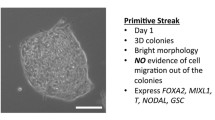Abstract
Embryonic stem (ES) cells can be valuable for monitoring differentiation processes and for improving applications in basic developmental biology. The application of ES cells can be a useful tool for drug discovery and toxicology. Therefore, we suggest the high-throughput screening (HTS) system based on ES cells in this study. Firstly, we optimized the feeder-free condition and seeding cell number which can maintained for at least 7 days without over-confluency. We analyzed the system by cell viability, proliferation activity, RT-PCR and morphologic/immunohistochemical evaluations. The optimal cell seeding number was 30/well that was maintained the typical colonial morphology over 9 d with 1,000 U/ml LIF in the limited space. The cell in optimized condition expressed ALP, SSEA-1, Oct 4 and Nanog and the genetic expressions showed similar to protein expressions. The cell lineage marker expressions showed faint or none. The cell viability and proliferation activity were increased in time-dependent manner in our optimized HTS system. In conclusion, the novel HTS system using ES cells can by useful for developing models for drug discovery as well as toxicological screening in the near future.
Similar content being viewed by others
References
Anderson, D.G., Levenberg, S., and Langer, R. (2004). Nanoliterscale synthesis of arrayed biomaterials and application to human embryonic stem cells. Nat. Biotechnol. 22, 863–866.
Bremer, S., van Dooren, M., Paparella, M., Kossolov, E., Fleischmann, B.K., and Hescheler, J. (1999). Effects of Embryotoxic Chemicals on the In vitro differentiation of genetically engineered embryonic stem cells into Cardiac cells. Toxicol In Vitro 13, 645–650.
Davila, J.C., Cezar, G.G., Thiede, M., Strom, S., Miki, T., and Trosko, J. (2004). Use and application of stem cells in toxicology. Toxicol. Sci. 79, 214–223.
Ding, S., and Schultz, P.G. (2005). Small molecules and future regenerative medicine. Curr. Top Med. Chem. 5, 383–395.
Evans, M.J., and Kaufman, M.H. (1981). Establishment in culture of pluripotential cells from mouse embryos. Nature 292, 154–156.
Jost, M.M., Budde, P., Tammen, H., Hess, R., Kellmann, M., Schulte, I., and Rose, H. (2005). The concept of functional peptidomics for the discovery of bioactive zeptides in cell culture models. Comb. Chem. High Throughput Screen. 8, 767–773.
Kunapuli, P., Zheng, W., Weber, M., Solly, K., Mull, R., Platchek, M., Cong, M., Zhong, Z., and Strulovici, B. (2005). Application of division arrest technology to cell-based HTS: comparison with frozen and fresh cells. Assay Drug Dev. Technol. 3, 17–26.
Martin, G.R. (1981). Isolation of a pluripotent cell line from early mouse embryos cultured in medium conditioned by teratocarcinoma stem cells. Proc. Natl. Acad. Sci. USA 78, 7634–7638.
Metzger, R., Deglmann, C.J., Hoerrlein, S., Zapf, S., and Hilfrich, J. (2001). Towards in-vitro prediction of an in-vivo cytostatic response of human tumor cells with a fast chemosensitivity assay. Toxicology 166, 97–108.
Pepperkok, R., and Ellenberg, J. (2006). High-throughput fluorescence microscopy for systems biology. Nat. Rev. Mol. Cell Biol. 7, 690–696.
Pouton, C.W., and Haynes, J.M. (2005). Pharmaceutical applications of embryonic stem cells. Adv. Drug Deliv. Rev. 57, 1918–1934.
Rohwedel, J., Guan, K., Hegert, C., and Wobus, A.M. (2001). Embryonic stem cells as an in vitro model for mutagenicity, cytotoxicity and embryotoxicity studies: present state and future prospects. Toxicol In Vitro 15, 741–753.
Tang, Y., Luo, J., Fleming, C.R., Kong, Y., Olini, G.C. Jr., Wildey, M.J., Cavender, D.E., and Demarest, K.T. (2004). Development of a sensitive and HTS-compatible reporter gene assay for functional analysis of human adenosine A2a receptors in CHO-K1 cells. Assay Drug Dev. Technol. 2, 281–289.
Thomson, J.A., and Marshall, V.S. (1998). Primate embryonic stem cells. Curr. Top Dev. Biol. 38, 133–165.
Thomson, J.A., Itskovitz-Eldor, J., Shapiro, S.S., Waknitz, M.A., Swiergiel, J.J., Marshall, V.S., and Jones, J.M. (1998). Embryonic stem cell lines derived from human blastocysts. Science 282, 1145–1147.
Vogel, R. (1993). In vitro approach to fertility research: genotoxicity tests on primordial germ cells and embryonic stem cells. Reprod. Toxicol. 7, 69–73.
Author information
Authors and Affiliations
Corresponding author
About this article
Cite this article
Cho, M., Cho, TJ., Lim, J.M. et al. The establishment of mouse embryonic stem cell cultures on 96-well plates for high-throughput screening. Mol Cells 35, 456–461 (2013). https://doi.org/10.1007/s10059-013-0083-0
Received:
Revised:
Accepted:
Published:
Issue Date:
DOI: https://doi.org/10.1007/s10059-013-0083-0




